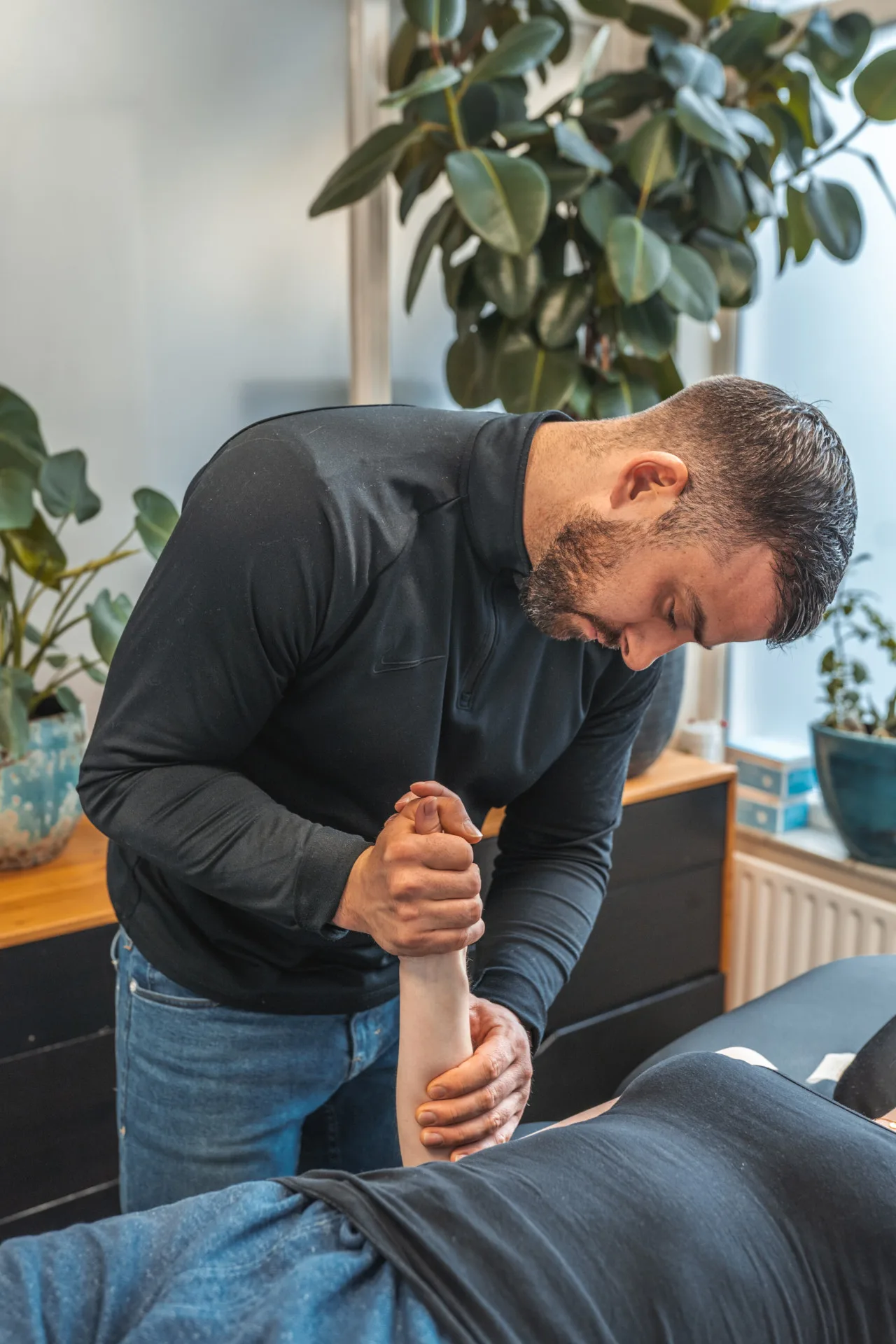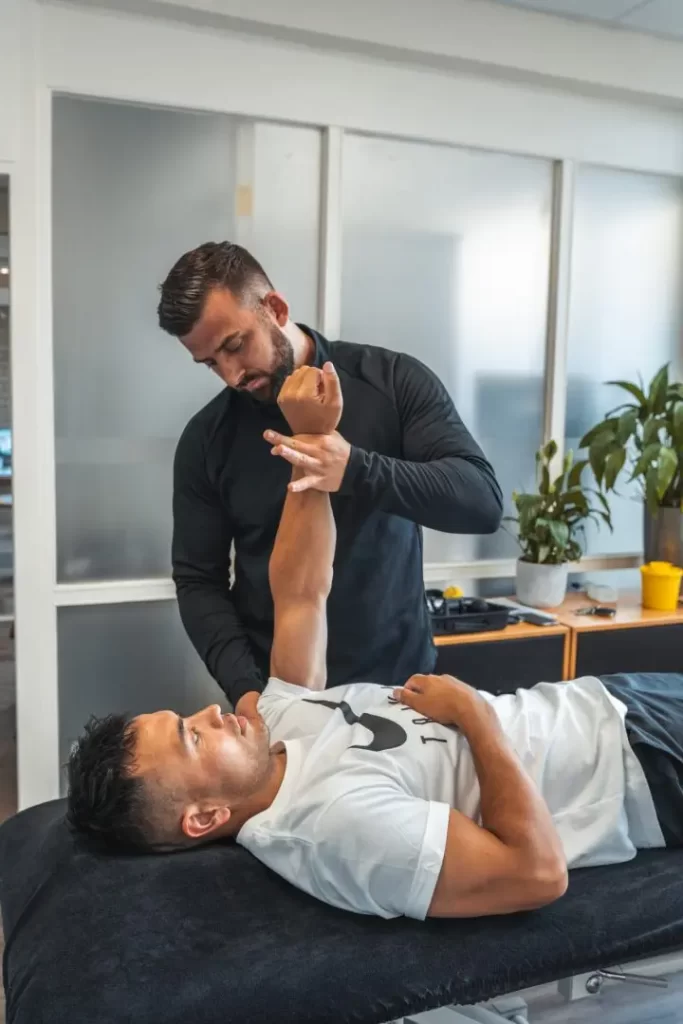Wrist complaints
Wrist problems are often complex can greatly affect your daily life. The wrist is a joint where many bones, ligaments, muscles and tendons come together and together they are responsible for stability, strength and a wide range of movements of the hand.
Complaints of the wrist can range from mild symptoms to severe pain and limitations due to a bone fracture, for example. These complaints can significantly hamper the use of the hand in daily life. Think of writing, typing, lifting or performing various sports activities.
At Fysio Fitaal in Tilburg, we are happy to help you recover from your wrist pain so you can get back to doing what you love without complaints!

Cause
Wrist pain can have several causes. One of the most common reasons is overuse of the wrist. Many repetitive movements, such as typing or working with tools, can irritate tendons and muscles in the wrist. Overuse is also common in sports that involve intensive use of the wrists. Think of tennis, gymnastics or weightlifting. This constant strain can lead to problems such as tendonitis or carpal tunnel syndrome, where a nerve in the wrist becomes irritated due to an inflammatory process in the wrist.
Besides these overuse injuries, acute injuries are another possible cause of wrist problems. A fall on the wrist or a wrong movement during sports can lead to sprains, strains or even more serious injuries. These complaints occur acutely and here there is obvious pain, swelling and limited range of motion of the wrist.
A seriously hard fall or other direct injury to the wrist, in the more serious cases, can lead to a bone fracture or damage to surrounding structures. Such cases often require intensive medical attention and well-supervised physiotherapy.
Sometimes wear and tear plays a role in wrist complaints. With prolonged strain or ageing, the cartilage in the wrist can gradually begin to show signs of osteoarthritis. Osteoarthritis in the wrist is characterised by stiffness, pain and reduced mobility, making daily functioning increasingly difficult. This process develops dormantly and often causes considerable restrictions in daily life in the long term.
Common Wrist complaints


Rowing wrist intersection syndrome
A rower's wrist, also known as intersection syndrome, is particularly common in rowers and sports...
Risk factors in wrist injuries
Wrist complaints can be affected by several factors. Some situations significantly increase the chances of developing symptoms.
Work overload is one of the most common causes. Occupations such as hairdressers, mechanics and people in industry often require repetitive movements or prolonged loading of the wrist. Little rest or low load capacity can lead to irritation, such as tendonitis or carpal tunnel syndrome.
Intensive sports such as gymnastics, tennis or weightlifting put stress on the wrists. In gymnastics, the wrists often support the body weight, while in tennis the repeated movements can actually cause complaints. Without proper technique and sufficient recovery time, overuse and injuries can occur.
Age is also an increased risk factor of acquiring osteoarthritis. This causes stiffness, pain and reduced mobility in the wrist. Although wear and tear is inevitable, a healthy lifestyle and regular exercise can help reduce symptoms.
Different type of wrist injury
Wrist complaints can be classified according to their cause, duration and specific features. This classification helps to better understand the problem and make the symptoms more insightful to choose the right treatment. Below Several possible subdivisions of wrist complaints.
Non-traumatic complaints arise without a direct cause. In this case, the symptoms are more gradual like overuse due to repetitive motion or wear and tear appropriate to osteoarthritis. So these complaints often develop gradually and require adjustments in load along with targeted exercises.
Traumatic complaints are caused by a sudden injury. Think of a fall or accident. Some cases involve a bone fracture, sprain or tearing of the ligaments, or so-called ligaments. Treatment focuses on repairing the anatomy, sometimes with necessary medical interventions such as surgery or casts.
Overuse complaints result from prolonged loading without adequate rest. This often occurs in intense sports or occupations with a lot of the same movements. Reducing strain and strengthening the wrist are essential in these.
Acute complaints occur suddenly, for example due to an accident or wrong movement. These symptoms are often accompanied by swelling and pain and require prompt treatment.
Specific complaints have an obvious cause. These can also be medically diagnosed. Consider carpal tunnel syndrome or osteoarthritis. Both these conditions can be confirmed by ultrasound or X-ray. A-specific complaints have no identifiable cause and are often related to multiple factors such as posture or mild overuse and thus cannot always be confirmed by imaging studies.
Anatomy of the wrist and hand
Making an appointment at FysioFitaal
We work from multiple locations in Tilburg, always close by for professional and accessible physiotherapy. Fill in the contact form and we will contact you soon. Together, we will work on your recovery!

